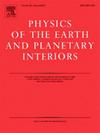1979年、1984年和2021年格拉纳达地震的阵列波束建模(西班牙南部)
IF 1.9
3区 地球科学
Q2 GEOCHEMISTRY & GEOPHYSICS
引用次数: 0
摘要
尽管过去在贝特山脉中部(西班牙南部)发生过大地震,但数字地震仪记录的地震活动仅限于小震级事件。在这里,我们感兴趣的是三个最强的事件(MW 4.5到5.0),它们的震源模型由于不同的原因而不清楚:1979年6月20日和1984年6月24日的地震仍然以缺乏区域记录为特征,而2021年8月12日的地震发生在一个M8级远震事件中。我们使用波束形成在遥远的地震阵列和波形建模的深度相位估计震源参数共7次地震。该技术成功地再现了p波波形,并估计了最近四次(1997-2021年)地震的深度。4. 此外,它还与产生类似于区域矩张量解的源机制的逆方案一起使用。反演表明,1984年和2021年的地震活动在7 km和9 km深度处存在正断层,这与我们对区域地震构造的理解是一致的。波束形成已经能够从M8尾波场中提取2021个波形,并且可能是一种适用于其他地震巧合情况的方法。最值得注意的结果是1979年地震在60公里深处的走滑机制,这是该地区的单一地壳下事件,可能与直布罗陀板块边缘的撕裂有关。本文章由计算机程序翻译,如有差异,请以英文原文为准。

Modelling array beams for the 1979, 1984 and 2021 Granada earthquakes (southern Spain)
Despite the occurrence of large, past earthquakes in the Central Betic Range (Southern Spain), seismicity recorded with digital seismographs is limited to small magnitude events. Here we are interested in the three strongest events (MW 4.5 to 5.0), of which source models are unclear for different reasons: The June 20th 1979 and June 24th 1984 earthquakes are still characterized by a lack of regional recordings, while the August 12th 2021 earthquake occurred during a teleseismic M8 event. We use beamforming at distant seismic arrays and waveform modelling of depth phases to estimate source parameters for seven earthquakes altogether. The technique is successful at reproducing P-waveforms and at estimating the depth of four recent (1997–2021) earthquakes with MW > 4. In addition, it is also used along with an inverse scheme that yields source mechanisms similar to regional moment tensor solutions. Inversion suggests normal faulting at depths of 7 km and 9 km for the 1984 and 2021 events, which is consistent with our understanding of regional seismotectonics. Beamforming has been able to extract the 2021 waveforms from the M8 coda wavefield, and could be a suitable approach also for other cases of earthquake coincidence. The most noteworthy result is a strike-slip mechanism at 60 km depth for the 1979 earthquake, which is a singular subcrustal event in this area and might be related to tearing at the edge of the Gibraltar slab.
求助全文
通过发布文献求助,成功后即可免费获取论文全文。
去求助
来源期刊

Physics of the Earth and Planetary Interiors
地学天文-地球化学与地球物理
CiteScore
5.00
自引率
4.30%
发文量
78
审稿时长
18.5 weeks
期刊介绍:
Launched in 1968 to fill the need for an international journal in the field of planetary physics, geodesy and geophysics, Physics of the Earth and Planetary Interiors has now grown to become important reading matter for all geophysicists. It is the only journal to be entirely devoted to the physical and chemical processes of planetary interiors.
Original research papers, review articles, short communications and book reviews are all published on a regular basis; and from time to time special issues of the journal are devoted to the publication of the proceedings of symposia and congresses which the editors feel will be of particular interest to the reader.
 求助内容:
求助内容: 应助结果提醒方式:
应助结果提醒方式:


